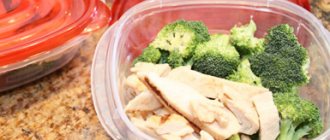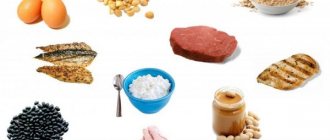In this article we will tell you:
- Classification of carbohydrates
- Daily intake of fructose and sugar
- Interesting facts about carbohydrates
- Foods rich in complex carbohydrates
- Daily carbohydrate intake and glycemic index
- 6 Rules for Eating Carbohydrates
- Symptoms and causes of carbohydrate metabolism disorders
- Low carb diets
- Fast carbohydrates for gaining muscle mass
- General carbohydrate intake recommendations
Complex carbohydrates are needed by the body to provide energy. Their deficiency causes a feeling of hunger. Many foods are rich in complex carbohydrates.
The main function of carbohydrates is to provide the body with energy. Although carbohydrates as sources of energy can be replaced by proteins and fats, the absence of carbohydrates in food can adversely affect health.
Classification of carbohydrates
Carbohydrates
- organic compounds that are part of all living organisms.
The lack of carbohydrates in food is manifested by symptoms reminiscent of starvation. There is rapid loss of water and sodium.
They are divided into monosaccharides, oligosaccharides and polysaccharides.
| Functions | Characteristic |
| Energy | The main substrate for energy production. |
| Structural | They are membrane components and participate in the production of lipids and non-essential amino acids. |
| Storage | Glycogen in the liver and muscles is a reserve of nutrients. |
| Regulatory | Digestive regulators. |
| Receptor | Cell receptors are glycoproteins. |
| Protective | Antibodies – glycoproteins, mucus, heparin. |
| Information | Ribose is a key component of RNA and DNA. |
- Simple carbohydrates
Water-soluble white crystals, sweet in taste, quickly absorbed, substrate for fermentation reactions. They have a higher glycemic index and cause insulin spikes in the blood.
Simple carbohydrates are called monosaccharides and oligosaccharides.
- Monosaccharides
Galactose, milk sugar, is a component of lactose and is found in milk.
Glucose, grape sugar - found in grapes, fruits, honey. It is the end product of the breakdown of complex carbohydrates in the body and is easily fermented.
Fructose, fruit sugar, is 2.5 times sweeter than glucose and does not cause a rise in insulin. Contained in honey and fruits. Worse to ferment.
- Oligosaccharides
Sucrose (glucose + fructose), cane beet sugar - table sugar. Contained in honey, dates, grapes, figs, persimmons, prunes, raisins. Displaces copper, chromium and B vitamins from the body, increasing the risk of developing CVD.
Lactose (glucose + galactose), milk sugar - easily transforms into adipose tissue (used for weight gain), stimulates the growth of lactic acid bacteria in the intestines.
Maltose (glucose + glucose), malt sugar, is an intermediate product of starch hydrolysis. Contained in wheat, rye, malt extracts, sprouted grains.
- Complex carbohydrates
Peculiarities:
- Low glycemic index.
- Does not cause insulin spikes.
- They have a mechanical effect on the intestines.
- Slow down the process of movement of the food bolus through the gastrointestinal tract.
Complex carbohydrates include polysaccharides. Polysaccharides are divided into homopolysaccharides and heteropolysaccharides.
- Homopolysaccharides
Starch is the stored energy of plants. Digestion of starch begins in the mouth. Contained in potatoes, cereals, pumpkin, peas.
Glycogen is animal starch, stored energy. Synthesized during digestion (1-2 hours after ingestion of carbohydrate foods), the largest amount of glycogen is stored in the form of granules in liver cells (2/5 - 150g), in skeletal muscles (1-3%), in the heart (0.5% ).
Cellulose (fiber) is the main component of the cell wall of higher plants, algae. Promotes the movement of food through the intestines, is broken down in the large intestine with the participation of microbiota, and inhibits the absorption of microelements.
Hemicellulose is better soluble in water and has sorption properties.
Lignin is the matrix of plants, determines their strength, the richest is coniferous wood, and from food sources: bran, stale vegetables. It is not digested in the intestines, reduces food digestion and absorption and has a high sorption capacity.
- Heteropolysaccharides
Pectin is present in the intercellular space of all higher plants, most of all in fruits. It has mild sorption and chelator properties.
We recommend
“Microelements in the body: consumption standards and methods of replenishing the deficiency” Read more
Inulin is similar to starch. Contained in underground parts of plants (mostly in Jerusalem artichoke, chicory), binds glucose, prebiotic.
Fructose consumption rate
Consumption rate: maximum 25 g per day.
In people with metabolic syndrome and risk factors: no more than 15 g.
50 g per day can cause metabolic syndrome and other diseases (metabolic gout).

Sources of fructose:
- Fruits.
- Vegetables.
- Honey.
- Products with fructose.
- High fructose corn starch.
- Sucrose – table sugar (glucose + fructose).
Sources of fructose in fruits and berries:
| Fruit | Size | Fructose (g) |
| Lime | 1 medium | 0 |
| Lemon | 1 medium | 0,6 |
| Cranberry | cup | 0,7 |
| Passion fruit | 1 medium | 0,9 |
| Plums | 1 medium | 1,2 |
| Apricot | 1 medium | 1,3 |
| Date (Deglet Noor) | 1 medium | 2,6 |
| Raspberries | 1 cup | 3,0 |
| Clementines | 1 medium | 3,4 |
| Kiwi | 1 medium | 3,4 |
| Blueberry | 1 cup | 3,5 |
| Cherries | 10 | 3,6 |
| Strawberry | 1 cup | 3,8 |
| Cherry | 1 cup | 4,0 |
| A pineapple | 1 piece | 4,0 |
| Grapefruit | 1.2 average | 4,3 |
| FRUIT | SIZE | GR. FRUCTOSE |
| Mandarin | 1 cup | 4,8 |
| Nectarine | 1 medium | 5,4 |
| Peach | 1 medium | 5,9 |
| Orange | 1 medium | 6,1 |
| Papaya | 1/2 medium | 6,3 |
| Honey Melon | 1/8 average | 6,7 |
| Banana | 1 medium | 7,1 |
| Date (Medjool) | 1 medium | 7,7 |
| Apple | 1 average | 9,5 |
| Melon farmer | 1/16 average | 11,3 |
| Pear | 1 medium | 11,8 |
| Grape | ¼ cup | 12,3 |
| Seedless grapes | 1 cup | 12,4 |
| Mango | ½ average | 16,2 |
| Dried apricots | 1 cup | 16,4 |
| Dried figs | 1 cup | 23 |
Are fruits really evil? No, fruit is not evil. Different fruits contain different amounts of fructose. Fruits reduce the risk of developing CVD due to their content of other nutrients and polyphenols. They are recommended in many diets, including the DASH (Diet to Stop Hypertension) protocol.

Studies have shown that fruit components such as vitamin C, resveratrol, polyphenols, and antioxidants improve the condition and function of blood vessels. Better fructose + vitamin C in fruits.
The fructose content of fruits is relatively low. The fructose content increases in fruit juices, as do calories. Some fruit juices contain up to 26 g of fructose per 450 g. Some restaurant desserts contain up to 60 g of fructose per serving.
Sugar intake per day
Free sugar = added by human hands.
Based on an average daily caloric intake of 2000 kcal, 10% free sugar from the total daily caloric intake of food.
Calculation example
:
- 10% of 2000 kcal = 200 kcal.
- 1 tsp without top sugar = 4 g.
- 1 g sugar = 4 kcal.
- 1 tsp = 16 kcal.
- 200 kcal = 12 tsp. Sahara.
- Daily sugar consumption 12 tsp.
BUT! This is a lot - maximum 50% - 6 tsp.
Another example of calculation for a box of chocolates. Total weight of the product in the box is 370 g. Quantity: 10 candies. 1 candy = 37 grams.
According to the labeling, 100 g of sweets contains 48 g of sugar. 1 candy 37 g = 17.7 g sugar.
17 g sugar = 4 tsp.
2 candies = reserve of “free sugar” allowed by the good WHO per day.
Interesting facts about carbohydrates
- Fats and carbohydrates are highly interrelated. When we don't have enough fat, we may crave carbohydrates.
- Carbohydrates are cellular “firewood”; their first and only function is to provide us with energy. No other molecule can provide as much energy without toxins.
- But besides this there are several more functions. Oddly enough, carbohydrates cannot be called an essential source of food. If there is a lack of carbohydrates, we can live without them, but there will be more toxins, less energy and a depressed state, but our body can create the carbohydrates that we need on its own!
- A carbohydrate is a mixture of carbon and water! Formed in plants under the influence of solar energy. Carbohydrates are an energy pantry: the body is able to store carbohydrates in reserve in the form of glycogen, which is stored in the liver and muscles.
- When the body does not have enough carbohydrates, it is ineffective, drowsy and in a bad mood.
- A special feature of carbohydrates is their ability to sharply increase blood glucose levels. The body’s reaction is immediate: a powerful release of insulin occurs in the pancreas - a hormone designed in this case to neutralize excess glucose in the blood, otherwise it will “thicken”. The main task of insulin is to deliver glucose to the cells that need it, in particular muscle cells.
- Body tissues have a limit for glucose absorption. By getting rid of its excess, insulin promotes its conversion into triglycerides, the main material of adipose tissue. Simple carbohydrates that are not used as sources of energy usually settle in the body in the form of hated subcutaneous fat. This is the reason obesity is so common among people who do not exercise. Their muscles practically do not need energy supply, and almost all the glucose received from food is converted into fat.
- With a sharp increase in blood glucose levels, the synthesis and storage of fat from carbohydrates, as well as the storage of fat from food, is activated. This happens even with a small amount of carbohydrates in food, but with their rapid absorption and with a sudden increase in blood glucose levels. This situation triggers the accumulation of fat in adipose tissue. A factor in the rate of carbohydrate absorption is the glycemic index (GI).
Tips for gaining weight
In the process of gaining muscle mass, the body is constantly transforming, and every day the usual menu becomes more and more boring. You should combine different products to satisfy the body's needs. Regardless of the number of muscles in the body, it is appropriate to adhere to the following rules:
- Divide the daily menu into several main meals (up to 6 times). The body will be able to gradually absorb all the necessary substances without stress and overload.
- Avoid destructive food processing and use only gentle cooking methods - boiling, baking, stewing. Eat fruits, vegetables and herbs raw.
- Do not exceed your fat intake. In addition to the total calorie content of foods, the balance of all nutrients is also important.
- Control the amount of muscle gain - body weight should not increase by more than 0.6-0.8 kg per week. The body will use excess weight to grow fat tissue.
- Maintain a balanced mental state. Stressful situations stimulate an increase in cortisol in the blood. It can destroy muscle fibers and cause fat accumulation.
Healthy, high-calorie foods make it easier to gain muscle mass. To achieve the desired effect, you need to take a responsible approach to menu planning and exercise regularly.
Foods rich in complex carbohydrates
| Product | Carbohydrate content per 100 grams, g |
| Cereals | |
| Cereals | 61 |
| Amaranth | 31 |
| Pearl barley | 65 |
| Bulgur | 76 |
| Millet | 67 |
| Brown rice | 74 |
| Wild rice | 75 |
| Whole grain spelled | 70 |
| Buckwheat | 57 |
| Quinoa | 64 |
| Barley grits | 66 |
| Whole wheat flour | 72 |
| Legumes | |
| Green pea | 15 |
| Beans raw | 12 |
| Dried beans | 49 |
| Chickpeas | 64 |
| Beans | 47 |
| Lentils | 60 |
| Peanut | 14 |
| Vegetables | |
| Carrot | 8 |
| Tomato | 4 |
| Celery | 2 |
| Beet | 6 |
| Turnip | 6 |
| Eggplant | 7 |
| Asparagus | 3 |
| Cucumber | 4 |
| Broccoli | 7 |
| Onion | 7 |
| Radish | 3 |
| Rhubarb | 4 |
| bell pepper | 7 |
| Fresh white cabbage | 5 |
| Red cabbage | 5 |
| Sea kale | 3 |
| Zucchini | 5 |
| Lettuce | 2 |
| Sorrel | 4 |
| Fruits | |
| Pomegranate | 15 |
| Green banana | 22 |
| Apples | 10 |
| Oranges | 8 |
| Figs | 12 |
| Peach | 10 |
| Pear | 11 |
| Grapefruit | 6 |
| Lemon | 3 |
| Avocado | 6 |
| Berries | |
| Cranberry | 4 |
| Prunes | 38 |
| Plum | 10 |
| Raspberries | 6 |
| Blueberry | 8 |
| Gooseberry | 9 |
| Strawberry | 8 |
| Cherries | 10 |
| Currant | 8 |
| Nuts, seeds | |
| Sunflower seeds | 16 |
| Pumpkin seeds | 17 |
| Linen | 12 |
| Sesame | 12 |
| Poppy | 15 |
| Hazelnut | 17 |
| Almonds raw | 20 |
| Cashew | 23 |
| Pine nut | 13 |
| Pistachios | 28 |
| Walnut | 16 |
List of foods for muscle growth
In order to increase muscle mass, you should consume a total of 500 kilocalories more proteins, fats and carbohydrates than the body expends during the day. The key to effective mass gain is increasing the calorie content of the diet, the correct balance of nutrients and the best foods for gaining body weight.
Protein products
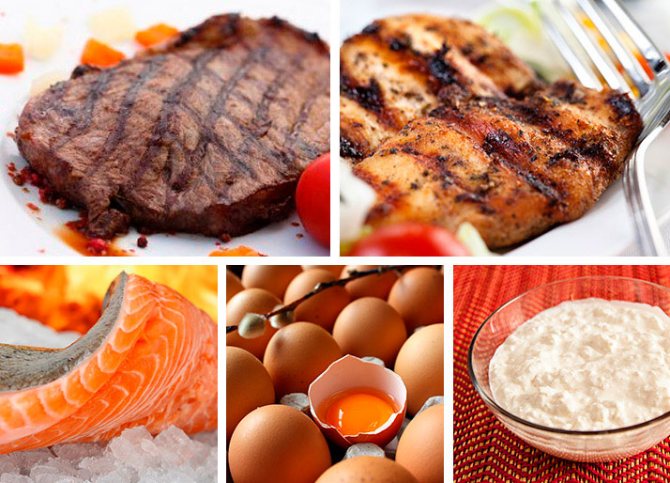
Proteins are the main building material of the body, responsible for the growth of muscle tissue and its restoration. A lack of protein in the body causes muscle wasting, weakened immunity, and swelling. The daily protein requirement for weight gain is 2-2.5 g/kg body weight. It should be taken in small portions throughout the day, since no more than 40 g are absorbed in one meal.
Proteins consist of many amino acids involved in the formation of hormones, complex enzymes and other cellular structures. The following products contain the largest amount of protein:
- Meat. Red beef, lean pork, lamb, chicken, turkey are foods high in protein (up to 24 g per 100 g). Meat contains 8 essential amino acids that the body is not able to synthesize on its own.
- Dairy products. The protein content in hard cheese is very high - 23-30 g. In combination with lipids and calcium, the protein is easily absorbed by cells. Depending on the fat content, milk has 2.8-3 g of protein, cottage cheese - 14-16 g.
- Eggs. One medium-sized chicken egg contains 6-8 g of pure protein. Egg yolk contains a large amount of cholesterol and fat, so consuming it in large quantities is harmful to health.
- Seafood. Per 100 g of fish fillet there are 17-25 g of protein, which is absorbed in full. Protein content in seafood: red caviar - 29-31 g, mussels - 20 g, shrimp, crab - 19 g, squid - 18 g. Such food is considered dietary - the level of fat in its composition is minimal.
- Beans. Vegetarians replenish their protein reserves through plants of the legume family. Per 100 g of soybeans there are 36 g of protein, chickpeas contain 19 g of protein, beans - 19-24 g, lentils - 21-24 g, peas - 20 g. To facilitate the digestion process, legumes are combined with vegetables.
- Nuts. Among the nuts, the most valuable are: peanuts and cashews (26-27 g of protein), pistachios (20 g), almonds (18 g), hazelnuts and walnuts (15 g).
- Cereals. The leader in the amount of protein in the composition is buckwheat (10-12 g per 100 g of cereal). Semolina, oatmeal and millet cereals contain about 10-11 g of protein.
- Mushrooms. The protein content in mushrooms is as follows: champignons – 4.3 g; porcini mushrooms, boletus, morels – 3-3.3 g; saffron milk caps, russula, honey mushrooms, boletus – 1.7-2.5 g.
- Vegetables. Among vegetables, the richest in protein are garlic (6.5 g), Brussels sprouts (4.8 g), and spinach (2.9 g).
Foods with healthy fats
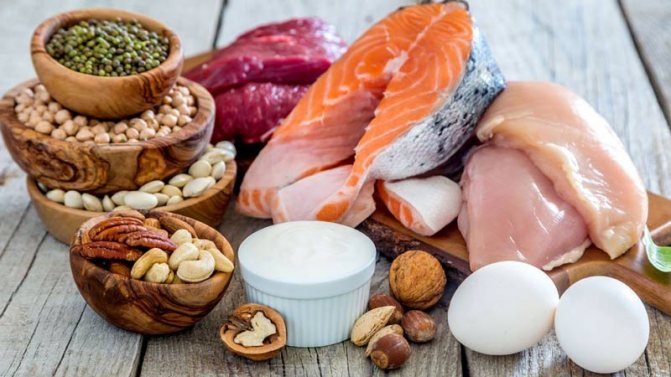
Fats are one of the most important nutritional elements. Their absence in the diet causes metabolic disorders, hormonal imbalance, and a decrease in overall immunity. Certain unsaturated fatty acids are not produced in cells; they are supplied exclusively in food.
The body's need for fat is 1 g/kg of dry body weight. The source of beneficial lipids should predominantly be plant foods (80%). Animal products occupy a small share in a healthy diet.
- Nuts. The fattest nuts – macadamia and pecan – contain 72-76 g of lipids per 100 g of product. Walnuts – 65 g, hazelnuts and pine nuts – 61 g; pistachios, almonds, cashews - 50-54 g, peanuts - 45 g. You cannot fill your entire daily diet with nuts - excess calories will lead to an increase in body fat.
- Seeds. Sunflower seeds contain 53 g of fat, sesame seeds - 49 g, poppy seeds - 47.5 g, flax seeds contain 42 g of lipids, chia seeds - 31 g, pumpkin seeds - 24.5 g.
- Oils. Sunflower oil is a high-calorie product, which mainly consists of polyunsaturated fats, which negatively affect human health. Healthy monounsaturated fats are found in olive, flaxseed, and corn oils.
- Avocado. A fruit that is 80% monounsaturated fatty acids. 100 g of avocado contains 15-20 g of fat.
- Dairy products. A large amount of fat can be obtained from hard cheeses (26-30 g), cottage cheese (9-18 g), and full-fat sour cream (20 g).
- Fatty fish. Mackerel, salmon, salmon, tuna are fish that, in addition to lipids (12-15 g), contain vitamins B and D, essential Omega-3 acids.
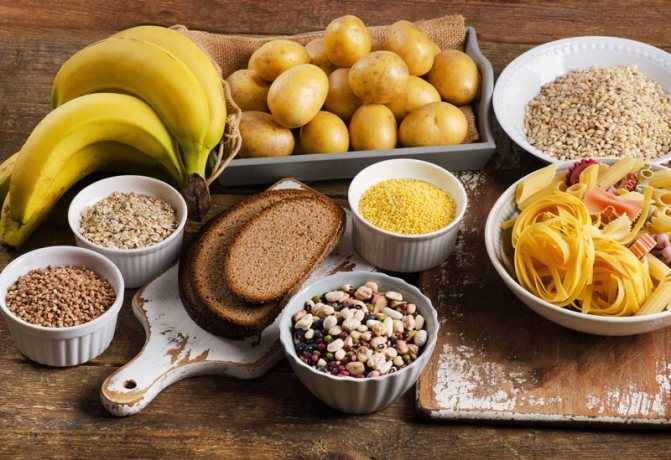
Sources of carbohydrates
Carbohydrates are the main energy resource and are most important during training. For an athlete, the norm of consumption is 4-5 g per 1 kg of body weight. 60-70% of the total amount of the substance should be complex (slow) carbohydrates, the rest - fast.
- Cereals. This is a source of slow carbohydrates, which provides the main energy reserves for the body. Semolina and pearl barley have 73.5 g of carbohydrates per 100 g, corn - 75 g, rice - 74 g, barley - 72 g, wheat - 70 g, oatmeal - 66 g, buckwheat - 62 g.
- Legumes. Peas contain 53-57 g of complex carbohydrates, beans - 54.5 g, lentils - 48-55 g. Legumes are rich in iron, vitamins A, C, B6, and magnesium.
- Pasta made from durum wheat. The starch in premium flour is not destroyed during cooking and saturates the body for a long time. There are 65-75 g of carbohydrates per 100 g of product.
- Vegetables. Corn – 22.5 g, garlic – 21.2 g, potatoes – 20 g, olives – 12.7 g, beets and parsley root – 11 g.
- Fruits. Fruits and berries consist mainly of fast carbohydrates: bananas - 22.4 g, grapes - 17.5 g, persimmons - 16 g, figs and mangoes - 14 g, pomegranate - 12 g, apples - 11.5 g, peaches - 10.5 g.
- Dried fruits. A convenient option for the cold season. Due to the small amount of water in the composition, dried fruits have a high calorie content and high carbohydrate content: dates - 75 g, raisins - 72 g, dried apricots - 61 g, figs - 58 g, prunes - 57.5 g
Water

Body tissues are 60-80% water. Active physical exercise increases your metabolic rate and stimulates sweating, causing your cells to require more fluid. Dehydrated blood slowly passes through the vessels, organs experience oxygen starvation, and the body’s endurance and performance decrease.
During the day, you need to drink water at the rate of 4% of your total body weight. During sports, cells intensively consume fluid for thermoregulation and metabolism. To reduce the stress on your heart and brain, you should drink small amounts of water throughout your workout.
It is important to know! Dehydration reduces the effectiveness of exercise. To protect the body from stress, it is necessary to replenish fluid reserves in a timely manner.
Daily carbohydrate intake
| Carbohydrates | Gram per day | Comments |
| Complex carbohydrates | 210 g | Try to avoid simple carbohydrates and maximum complex ones |
| Cellulose | 40 g | |
| Fructose | 25 g | Glycation reactions |
| Sucrose | 25 g, max 50 g | WHO recommends no more than 10% of all carbohydrates, ideally no more than 5% |
| Total | 300 g | For a person with average physical load |
Glycemic index of carbohydrates
The glycemic index of carbohydrates is influenced by:
- Carbohydrate structure
The most easily digestible carbohydrate is glucose, since after absorption it can be directly delivered by the blood to organs and tissues. Accordingly, other carbohydrates first require conversion to glucose.
Fructose, although a monosaccharide, requires a fairly long sequence of biochemical reactions to be converted into glucose and therefore has a relatively low glycemic index for a monosaccharide.
On the other hand, most disaccharides (sucrose, lactose) contain a relatively easily cleaved glucose fragment in the molecule. For example, the GI of maltose (malt sugar) for glucose is above 100, since the molecule consists of two glucose molecules.
- Particle size
The smaller the particles of carbohydrate food (for example, flour milling), the faster they are digested in the gastrointestinal tract.
- Degree of heat and cooking
Starches are partially broken down when heated. Consequently, the glycemic index increases with increasing duration and intensity of heating. An acidic environment also promotes the breakdown of starches.
- Content of fiber, protein and fat in the product
All these components slow down the absorption of carbohydrates. Fat also slows down secretion, which means the time food stays in the stomach increases. Carbohydrates are mainly absorbed in the intestines, therefore, the faster they get there, the higher the glycemic index.
- Food consistency
Naturally, liquids are the easiest to digest. The presence and density of cell membranes, various partitions and fibrous structures are also important.
- Food absorption rate
On the one hand, hasty swallowing partially speeds up the processing of food, on the other hand, the presence of unchewed pieces interferes with the full absorption of food components.
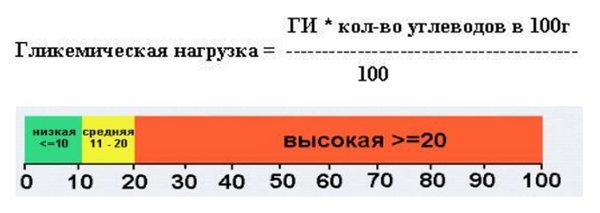
Using this formula as an example, you can compare the glycemic index of a donut and watermelon
:
Donut GI = 76, carbohydrate content 38.8. GN = (76 * 38.8): 100 = 29.5 g.
Watermelon GI = 75, carbohydrate content 6.8. GN = (75 * 6.8): 100 = 6.6 g.
Glycemic load:
Symptoms and causes of carbohydrate metabolism disorders
The meaning of carbohydrate metabolism is the release of energy through glucose.
Ways of glucose utilization
:
- entry into cells as a source of energy;
- conversion to glycogen (serves as the main storage carbohydrate and the main form of glucose storage) in the liver and muscles;
- conversion to fatty acids (storage as fat).
Laboratory diagnostics of carbohydrate metabolism
:
- insulin (the norm of insulin is not higher than 5-6, the ideal insulin is 3-4) glucose (the optimum is not higher than 5);
- glycated hemoglobin (shows how “saccharified” our red blood cells have been over the last 3 months, optimal 4-5).
Symptoms of carbohydrate metabolism disorders
:
- dizziness when not eating for more than 3 hours, standing up suddenly or during physical activity;
- you cannot calmly stand a pause of 4-5 hours without food;
- craving sweets and fast carbohydrates, and when you start eating, you can’t get enough;
- behave aggressively when hungry;
- you are overweight and cannot lose it.
Causes of carbohydrate metabolism disorders
:
- Excessive glucose intake.
- Consumption of liquid sugars (any sweet drinks).
- Excessive intake of foods with a high glycemic index.
- Excessive intake of foods with a high insulin index.
We recommend
“Physiology of digestion: stages, organs, enzymes” Read more
Strategy for correcting carbohydrate metabolism
:
- Training food breaks between meals: dinner and breakfast, no snacks!
- Correction of the diet towards LCHF or reducing the carbohydrate load.
- Protein-fat breakfast and low-carb dinner.
- Elimination of simple carbohydrates and glycation products.
- Movement (10,000 steps per day + strength training).
- Do not sit in one place for more than 30 minutes.
Slow and fast carbohydrates
It's no secret that carbohydrates are different from carbohydrates.
Because both Napoleon cake and celery are carbohydrates. And, of course, not all carbohydrates are created equal. Slow and fast carbohydrates are called according to the speed of their breakdown into the glucose necessary for the body, for the processing of which insulin is responsible. With a large consumption of fast carbohydrates, too much glucose is formed in the body. This is fraught not only with weight gain, but also with serious disruptions in the functioning of the endocrine system and the body as a whole. Excess glucose in the body then provokes a sharp drop in sugar levels. Which, at the slightest activity, entails a strong feeling of hunger, which, of course, you want to drown out by eating again.
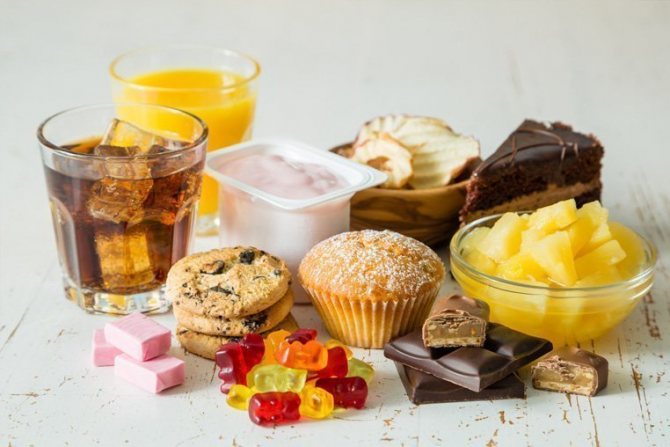
A strong blow falls on the pancreas, which is responsible for the production of insulin - it has to constantly work in emergency mode, either producing a large amount of insulin in the shortest possible time, or “freezing”, waiting for a new portion of carbohydrates.
The level of the hormone serotonin depends on the blood sugar level, which means that with this regimen, sudden mood changes are guaranteed.
In turn, slow carbohydrates are processed slowly by the pancreas, it does not experience overload and operates normally. The feeling of hunger comes in a timely manner, and there are no mood swings.
To correctly calculate the healthy carbohydrates you consume daily, print out a table of foods indicating the carbohydrate content and glycemic index of the foods. This will help adjust the menu.
To determine whether carbohydrates are fast or slow, a special glycemic index was developed, which is the basis for many diets and nutritional regimens. It's simple - the higher the index, the “faster” the carbohydrate.
Low carb diets
Possible dietary strategies (you must first look at the state of the gastrointestinal tract):
- LCHF
- Keto diet
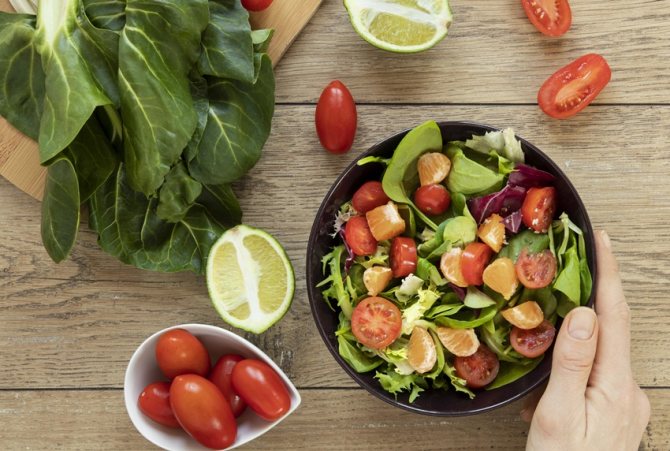
Basic principles of low-carb diets
:
- Low frequency of meals: ideally 3 meals a day without snacks, observing “clean” intervals.
- Intermittent fasting: 8-10 hours eating, 14-16 hours without food.
- Intermittent 24 hour fasting. Starts from lunch on day X until lunch the next day (for kapha types it may be longer).
- Remove from your diet cereals, baked goods and pasta, legumes, sweets and fruits with a high GI, carbonated drinks (even zero-calorie drinks), juices, candy bars, ketchup (with sugar), etc.
- Increase the consumption of protein products to 0.8-1.0 g/kg/day (it is better to use fatty meats: pork, lamb, beef, seafood, chicken, turkey; eggs in unlimited quantities).
- Carbohydrates 120-175 grams/day.
- Fats as saturated.
- A sufficient amount of fiber in the form of fresh vegetables and herbs.
- Eat foods with natural fat content (exclude low-fat yoghurts, cottage cheese less than 9% fat, butter no less than 82%).

Introduce healthy fats into your diet
:
- ghee and butter;
- Coconut oil;
- avocado oil;
- olive oil.
Avoid oils high in omega-6 (pro-inflammatory)
:
- sunflower;
- corn;
- cotton;
- rapeseed
The food is as natural as possible, according to the principle “the simpler the better.”
Effects of intermittent fasting
:
- increases metabolic rate;
- reduces insulin levels, allowing metabolism to switch to burning fat;
- restores tissue sensitivity to insulin and leptin;
- activates recovery processes in the body (autophagy).
| LCHF | KETO | |
| BJU | 20% / 65% / 15% | 20% / 75% / 5% |
| Carbohydrates | from 60-75 to 175 grams per day | no more than 30 grams |
| Squirrels | 1-1.2 grams per kg/day | 0.8-1.0 grams per kg/day |
| Fats | as it saturates | as it saturates |
| addictive | easier | more difficult |
| Diversity | more | less |
| Long term | Unlimited | As a treatment strategy |
| results | slower | faster |
High calorie diet menu
Any high-calorie diet menu is organized according to the principles of fractional meals. The meaning is utilitarian, it’s not at all about “promoting metabolism” or similar mythical things. Large amounts of food are quite difficult to digest, so each serving should be medium in volume. In the practice of sports, during periods of “forced overeating”, enzymes for digestion are also taken. But this is not necessary for everyone, because there are also people with naturally good gastrointestinal activity.
A common mistake is to increase your caloric intake only through sugar and saturated fat. Of course, a high-calorie diet allows their consumption, but an excess of these substances in the diet can lead to damage to the liver and pancreas. This is especially likely in those people who are already predisposed to diseases. Therefore, food should still be closer to healthy than to “any”.
A sample menu might look like this:
Breakfast: 2-3 scrambled eggs with low-fat bacon, vegetables.
Second breakfast: muesli with nuts, dried fruits, kefir or milk, fruit if desired.
Lunch: any side dish of cereal, a portion of meat dish, vegetable salad, tea with dried fruits or banana.
Snack: again cereal, a portion of meat or fish, a portion of healthy fats.
Before training: a protein shake with juice or banana (sometimes both), or cookies with tea and any dairy product of your choice.
Dinner: again meat or fish, a side dish of cereals, can be replaced with potatoes or pasta if they are digested normally. Vegetables of your choice.
Before bed: a portion of cottage cheese; if fructose is well tolerated, you can add honey and fruit; if not, it’s better to replace it with pure casein protein.
From time to time you can have free meals - pastries, pancakes, sweets, but the point is not to eat only them. You need to follow general recommendations for creating a healthy menu, and make sure that sweet and objectively harmful foods are in your diet only 1-2 times a week, and not every day.
Fast carbohydrates for gaining muscle mass
If you have a desire not only to lose weight, but also to build muscle, then you will need to carefully plan your diet: include foods that will quickly compensate for the muscle glycogen consumed during training.
How do carbohydrates and glucose “work” in the body? They enter the blood, brain, and muscle tissue. As for muscles specifically, carbohydrates and glucose seem to activate them, stretch the cells, increase their energy, and at the same time, their size.
Thus, when there is already enough glucose in the muscles, all its excess is converted into fat. This is why simple carbohydrates are dangerous for those who lead a sedentary lifestyle.
But for people actively involved in sports, everything happens differently:
- If you didn’t have a normal meal a little earlier, and you need energy for training, then an hour before the start of class it would be good to eat something with fast carbohydrates. They will provide enough energy, and the workout will take place in the desired mode.
- Carbohydrates will prevent muscle glycogen from falling to critically low levels, meaning you'll get more out of your workout. When the goal is to build muscle, you have to exercise especially actively and glycogen is consumed very quickly.
After completing a workout, the best way to replenish energy is also to take fast carbohydrates. Athletes here use the term “carbohydrate window”, which is what they call the first 30-60 minutes after an intense workout. It is at this time that glucose is absorbed into the blood most intensively, so the body will quickly receive the carbohydrates contained in the foods you eat.
If there is too much glucose, then in a given period of time it does not accumulate as fat. The body transforms it into glucogen and stores it in the liver as an energy reserve. Thus, when an athlete eats something tasty at the end of a workout, he replenishes his energy supply and rests peacefully, while his muscle mass grows.
We recommend
“Proper nutrition as a factor in maintaining human health” Read more
Fast carbohydrates eaten immediately after strength training are good because they do not transform into fat.
If there are no workouts on certain days, then give preference to complex carbohydrates (cereals, legumes, tubers, etc.) as part of a complete diet. But when you train, remember about the “carbohydrate window”. At this time, you can calmly eat something tasty and sweet.
The basis of the diet for weight gain
A monotonous diet is one of the reasons for excessive thinness. A lack of nutrients needed for muscle building and proper energy metabolism usually leads to weight loss. Reviewing your diet is the first step to solving the problem.
High-calorie foods for weight gain should be included in the daily menu in proportions that allow you to maintain the correct balance of proteins, fats and carbohydrates (BJC).

You can achieve the desired result with the following nutrient content in your diet:
- 35/15/50 – the ideal ratio of BZHU for building muscle mass. Recommended for professional athletes and men;
- 25/15/60 – the combination is designed to slightly increase muscle volume. Suitable for women and girls leading a moderately active lifestyle.
Maintaining the recommended balance of nutritional supplements in combination with a calorie surplus will allow you to gain weight. If you add strength training to a well-designed diet, then weight gain will occur due to muscles, not fat deposits.
The basis of the diet for weight gain consists of foods high in protein, which is a building material for muscles, performs the function of maintaining immunity and takes part in various biochemical processes.
These include:
- lean meat;
- fish;
- legumes;
- nuts;
- eggs;
- dairy products.
Energy value 1 g. protein is 3.8 kcal. It is also necessary to consume complex (or slow) carbohydrates, which provide the body with energy, but do not increase blood sugar levels and do not transform into fats. They contribute to the generation of insulin, a natural anabolic steroid that stimulates muscle growth.

This group includes:
- bakery products made from wholemeal flour;
- cereals and beans;
- pasta from durum wheat;
- low sugar fruits;
- greens and vegetables.
Energy value 1 g. carbohydrates is 4 kcal. It is strictly forbidden to exclude fats from the diet. In a balanced diet, the proportion of their content should be at least 15%.
A strong reduction in fat consumption is fraught with hormonal imbalances, slower body weight gain, metabolic disorders, a negative effect on reproductive function and a deterioration in the absorption of fat-soluble vitamins A, D and E.
Sources of healthy fats include:
- some types of fish (tuna, salmon);
- beef and pork;
- dark chocolate;
- walnuts, pistachios, almonds;
- avocado;
- olives and olive oil.

Energy value 1 g. fat is 9.5 kcal. To create a balanced menu, it is necessary to determine the calorie content of the daily diet, the calculation formula of which is universal for men and women and is as follows: K = Bx30 + P, where: K is the number of calories; B – weight in kg; P – increasing coefficient, depending on body type.
There are 3 types of build:
| View | Description | Coefficient value |
| Ectomorphs | Energetic, active, lean people with good metabolism. They are distinguished by an elegant physique and underdeveloped muscles. They are not inclined to be overweight and have difficulty gaining muscle mass. | 1000 |
| Endomorphs | The complete opposite of ectomorphs. People with a slow metabolism and overweight. As a rule, they lead a sedentary lifestyle that does not require large energy expenditures. | 500 |
| Mesomorphs | People with a normal physique. They are naturally in good physical shape and do not need additional means to maintain it. | 500 |
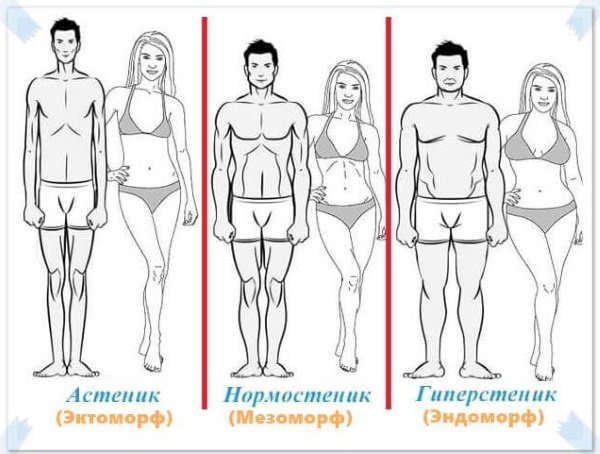
An example of calculating the calorie intake for an ectomorph male weighing 70 kg:
K=70x30+1000=3100 kcal/day.
With a BJU proportion of 35/15/50, the daily menu should contain:
- proteins – 1085 kcal or 285 g;
- fats – 465 kcal or 49 g;
- carbohydrates – 1550 kcal or 388 g.
However, a balanced menu does not guarantee 100% results.
There are several rules to follow when gaining weight:
- eat as often as possible. It is recommended to divide the diet into 5-7 meals;
- there is no need to try to gain weight by increasing the amount of food you eat and increasing the amount of carbohydrates. The goal of proper weight gain is to get a healthy body, not to get fat;
- It is recommended to drink a glass of juice half an hour before meals, this stimulates the appetite;
- You need to get used to starting the day with a full breakfast. It has been scientifically proven that the most active saturation of the body with proteins and carbohydrates occurs with the first meal;
- you should not overeat, because this can negatively affect your well-being;
- It is not recommended to perform active activities immediately after eating;
- you need to reduce your caffeine intake;
- It is advisable to completely quit smoking.

If the goal is simply to gain weight and not build muscle mass, it is better to limit physical activity and get more rest.




